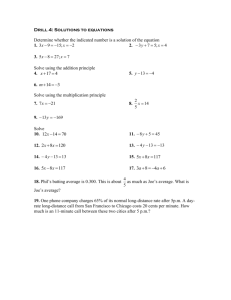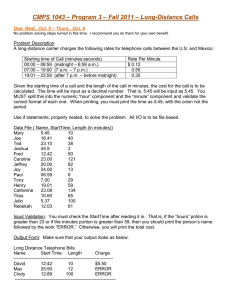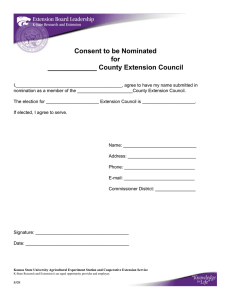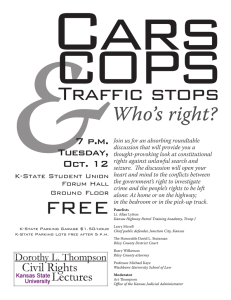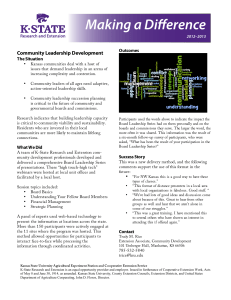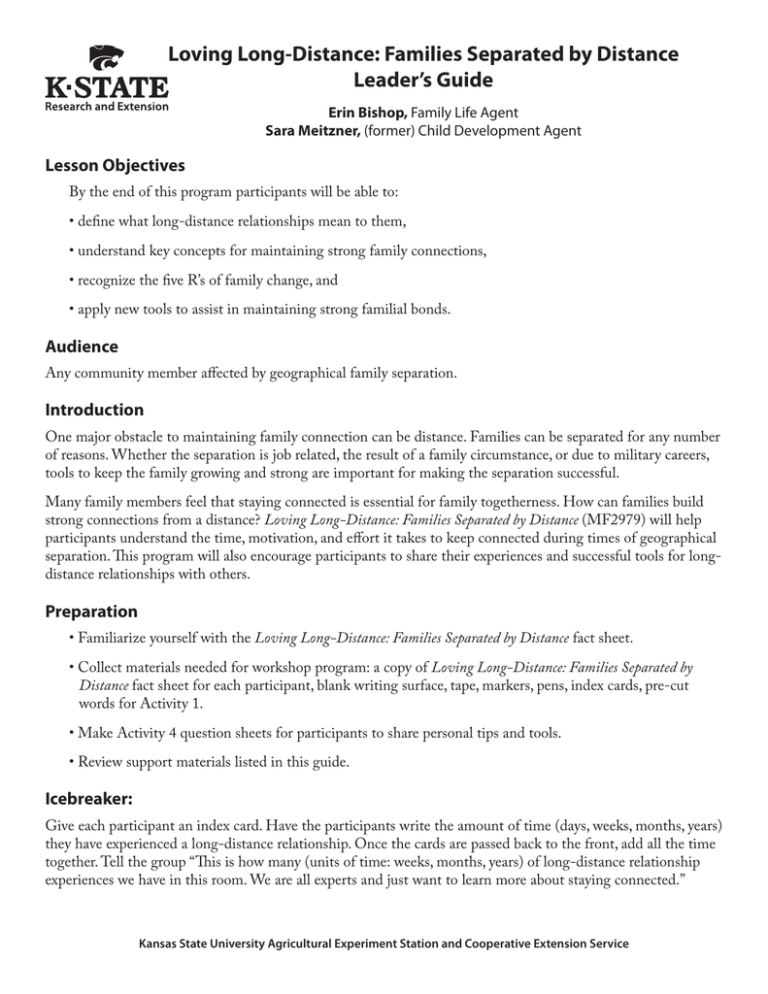
Loving Long-Distance: Families Separated by Distance
Leader’s Guide
Erin Bishop, Family Life Agent
Sara Meitzner, (former) Child Development Agent
Lesson Objectives
By the end of this program participants will be able to:
• define what long-distance relationships mean to them,
• understand key concepts for maintaining strong family connections,
• recognize the five R’s of family change, and
• apply new tools to assist in maintaining strong familial bonds.
Audience
Any community member affected by geographical family separation.
Introduction
One major obstacle to maintaining family connection can be distance. Families can be separated for any number
of reasons. Whether the separation is job related, the result of a family circumstance, or due to military careers,
tools to keep the family growing and strong are important for making the separation successful.
Many family members feel that staying connected is essential for family togetherness. How can families build
strong connections from a distance? Loving Long-Distance: Families Separated by Distance (MF2979) will help
participants understand the time, motivation, and effort it takes to keep connected during times of geographical
separation. This program will also encourage participants to share their experiences and successful tools for longdistance relationships with others.
Preparation
• Familiarize yourself with the Loving Long-Distance: Families Separated by Distance fact sheet.
• Collect materials needed for workshop program: a copy of Loving Long-Distance: Families Separated by
Distance fact sheet for each participant, blank writing surface, tape, markers, pens, index cards, pre-cut
words for Activity 1.
• Make Activity 4 question sheets for participants to share personal tips and tools.
• Review support materials listed in this guide.
Icebreaker:
Give each participant an index card. Have the participants write the amount of time (days, weeks, months, years)
they have experienced a long-distance relationship. Once the cards are passed back to the front, add all the time
together. Tell the group “This is how many (units of time: weeks, months, years) of long-distance relationship
experiences we have in this room. We are all experts and just want to learn more about staying connected.”
Kansas State University Agricultural Experiment Station and Cooperative Extension Service
Activity 1
Divide a blank writing surface down the middle with a line. On one side write “together” and on the
other side write “apart.” Using the pre-cut words, have participants discuss if the word shown describes a
relationship that is “together” or a relationship that is “apart.” Tape the words to the appropriate category.
Some words may fit both categories and can be placed on the middle line.
These words can include: Trust, Sharing, Complicated, Stressful, Difficult, Connected, Negotiate, Easy,
Normal, Maintaining, Conflict, and Satisfaction.
Discuss why participants placed each word into the specific category. The central theme should be that all
relationships take work, whether people are geographically together or separated.
Activity 2
How does a relationship change during geographical separation? Use Mary Dooley Burns’ “5 R’s” to
explore this concept with participants. (Found in reference section, Parenting Alone Together . . . How Does
Our Family Change?)
Read each definition and discuss as a group. These can be found in the fact sheet.
Encourage participants to share personal experiences with the group.
Activity 3
Review the “Tips for Staying Connected” section in the facts sheet. This information is from North
Dakota State University Extension Guide titled Making the Connection: Builiding Long-Distance
Relationships Member’s Guide.
Ask participants to add their own “tips” to the list.
Activity 4
Place four sheets with a question on each around the room, with a marker at each station. Have
participants share personal experiences and answers on each question. Examples of questions include:
“How will we celebrate holidays and special occasions?” “How will we keep in touch?” “What is one
family rule that we have?” “What ‘job’ do I do at home now?”
Once participants have completed the activity, review the answers as a group. Allow time for clarification
on any answers.
Wrap-Up Activity
As a final activity, ask the participants to each share one possible new tool they can use in strengthening
their connections over long distances.
Community Awareness
Educate community leaders on the importance of helping families stay connected during times of
geographical separation.
Interview leaders, groups, citizens and others on their own personal experiences with long-distance relationships.
Present information and provide Loving Long-Distance program to groups that are likely to experience longdistance relationships (i.e. military populations, business travelers, communities with transient populations).
References and Resource Materials
Brotherson, S. (2002). Making the connection: Building long-distance relationships; Member’s Guide, Handouts
#1, #2, #3, and Overhead #1. North Dakota State Extension Services. http://www.ag.ndsu.edu/family/familycommunity-education/making-the-connection.
Burns, Mary Dooley. (1994). Parenting Alone Together ... How Does Our Family Change? The 5 R’s. Minneapolis,
MN: Family Information Services.
Hill, M. J. (1996). Keeping in touch: When distance keeps you apart; Fact Sheet. Ohio State University Extension.
Hill, M.J. (1997) Welcome Back! Here’s what’s been happening while you were gone; Fact Sheet. Ohio State
University Extension.
Military OneSource. (no date) Double Duty: Staying connected with your kids when you’re a deployed dad. (CD) http://
www.militaryonesource.com/MOS/FindInformation/Category/Topic/Issue/Material.aspx?MaterialID=16611&Materia
lTypeID=0; (800) 342-9647.
The National Institute for Building Long Distance Relationships (2001). Dads at a distance: An activities
handbook for strengthening long distance relationships. A&E Family Publishers, Provo, Utah.
Uniformed Services University of Health Sciences (2004). Becoming a couple again: How to create a shared sense of
purpose after deployment. www.usuhs.mil; Bethesda, MD.
Reviewers
Charlotte Shoup Olsen, Ph.D., Specialist, Family and Marital Relationships, K-State Research and Extension
and Professor, Kansas State University Family Studies and Human Services.
Anna Mae Brown, Family and Consumer Sciences Agent, K-State Research and Extension – Crawford County
Brand names appearing in this publication are for product identification purposes only. No endorsement is intended,
nor is criticism implied of similar products not mentioned.
Publications from Kansas State University are available at: www.ksre.ksu.edu
Publications are reviewed or revised annually by appropriate faculty to reflect current research and practice. Date shown is that
of publication or last revision. Contents of this publication may be freely reproduced for educational purposes.
All other rights reserved. In each case, credit Erin Bishop, et al, Loving Long Distance: Families Separated by Distance,
Leader’s Guide, Kansas State University, July 2011.
Kansas State University Agricultural Experiment Station and Cooperative Extension Service
MF2980
July 2011
K-State Research and Extension is an equal opportunity provider and employer. Issued in furtherance of Cooperative Extension Work, Acts of May 8 and June 30, 1914,
as amended. Kansas State University, County Extension Councils, Extension Districts, and United States Department of Agriculture Cooperating, Gary Pierzynski, Interim
Director.

